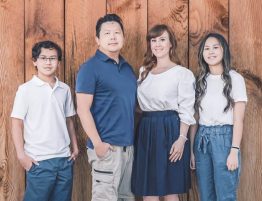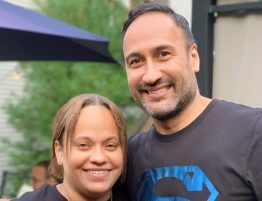
The morning of Terrianne Zonca’s grandfather’s funeral in Honolulu, she was so busy getting ready that she forgot to eat breakfast.
Before going to the mortuary, Zonca’s family gathered at her parents’ house. They shared a glass of sake in honor of her beloved grandfather.
When the service started, Zonca’s heart was racing. Her palms were sweating. She felt jittery. She figured her body was reacting to her emotions. As her turn to speak approached, the sensations heightened. She turned to her husband, Derrick, for a big bear hug to calm her.
Walking to the podium, Zonca noticed that none of the other grandkids were following her. The plan had been for her to speak and them to stand beside her representing their generation.
I guess I’m doing this on my own, she thought.
The words didn’t come. She froze. Zonca’s parents turned to her brother and younger cousin and said, “You need to get up there.”
But there was no time. In that same moment, Zonca’s heart stopped. She was in cardiac arrest.
Two of Zonca’s cousins – both nurses – ran to her. Unable to detect any breathing, they screamed for someone to call 911 and started CPR. They also asked for an AED, an automated external defibrillator; the mortuary had one. A staff member in the room ran to the hallway to retrieve it and was back in less than a minute.
The device can help restart a heart’s rhythm. The first shock didn’t do it. A second shock didn’t. That’s when paramedics arrived and took over.
Zonca was awake when she arrived at the hospital. When doctors asked her to wiggle her hands or feet, she couldn’t. They placed her in a medically induced coma to help her brain and body heal from the trauma.
Three days later, she was brought out of the coma. She was understandably confused when she woke up.
She figured she’d just had an “episode” that was more severe than others.
For the last 18 years – since she was a senior in high school – Zonca had dealt with fainting spells a few times a year. Doctors never found out why. There was no real pattern to the episodes.
As she went from an active teenager to a professional dancer (she’s performed on everything from theater stage performances to Disneyland), the theory was that she exhausted herself. The fact she often forgot to eat breakfast or drink enough water supported the theory.
Her cardiac arrest forced doctors to take a closer look. While Zonca was still in the coma, they discovered that she had a rare condition called long QT syndrome, a disorder of the heart’s electrical system that can cause irregular and potentially fatal heartbeats. Once Zonca was conscious and alert, doctors delivered the news.
To keep her heart safe, doctors implanted in her chest a device that monitors for any abnormal rhythms and, if so, can shock her heart back into a normal rhythm. It’s called an implantable cardioverter defibrillator.
Zonca’s episode occurred last July. Doctors told her that to continue her passion for dancing safely, she’d need to dial back on how often she does so and how much she exerts herself.

Today, she still dances full time. One of her medicines suppresses her adrenaline, which helps keep her heart regulated but makes it more challenging for her to get through a performance. The tradeoff, however, is worth it.
“I’m grateful I get to do something I love, even being diagnosed with something that could have taken my life,” said Zonca, who recently moved back to Hawaii from California to be near family.
Since her cardiac arrest, Zonca has become an advocate for the American Heart Association and is a regular at its Heart Walks, sharing her story with others and the importance of CPR.
“Had my cousins not stepped in the split second they did, doctors said I would not have made it,” she said. “They saved my family from having to figure out another funeral.”

Stories From the Heart chronicles the inspiring journeys of heart disease and stroke survivors, caregivers and advocates.





